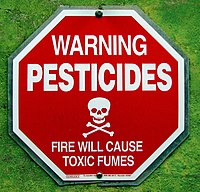
Photo from wikipedia
Background The association between prenatal pesticide exposures and a higher incidence of small-for-gestational-age (SGA) births has been reported. No prediction model has been developed for SGA neonates in pregnant women… Click to show full abstract
Background The association between prenatal pesticide exposures and a higher incidence of small-for-gestational-age (SGA) births has been reported. No prediction model has been developed for SGA neonates in pregnant women exposed to pesticides prior to pregnancy. Methods A retrospective cohort study was conducted using information from the National Free Preconception Health Examination Project between 2010 and 2012. A development set (n = 606) and a validation set (n = 151) of the dataset were split at random. Traditional logistic regression (LR) method and six machine learning classifiers were used to develop prediction models for SGA neonates. The Shapley Additive Explanation (SHAP) model was applied to determine the most influential variables that contributed to the outcome of the prediction. Results 757 neonates in total were analyzed. SGA occurred in 12.9% (n = 98) of cases overall. With an area under the receiver-operating-characteristic curve (AUC) of 0.855 [95% confidence interval (CI): 0.752–0.959], the model based on category boosting (CatBoost) algorithm obtained the best performance in the validation set. With the exception of the LR model (AUC: 0.691, 95% CI: 0.554–0.828), all models had good AUCs. Using recursive feature elimination (RFE) approach to perform the feature selection, we included 15 variables in the final model based on CatBoost classifier, achieving the AUC of 0.811 (95% CI: 0.675–0.947). Conclusions Machine learning algorithms can develop satisfactory tools for SGA prediction in mothers exposed to pesticides prior to pregnancy, which might become a tool to predict SGA neonates in the high-risk population.
Journal Title: Frontiers in Public Health
Year Published: 2022
Link to full text (if available)
Share on Social Media: Sign Up to like & get
recommendations!